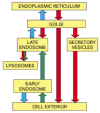By agreement with the publisher, this book is accessible by the search feature, but cannot be browsed.
NCBI Bookshelf. A service of the National Library of Medicine, National Institutes of Health.
Alberts B, Johnson A, Lewis J, et al. Molecular Biology of the Cell. 4th edition. New York: Garland Science; 2002.

Molecular Biology of the Cell. 4th edition.
Show detailsEvery cell must eat, and it must communicate with the world around it. In a procaryotic cell, all the eating and communicating takes place across the plasma membrane. The cell secretes digestive enzymes, for example, across the plasma membrane to the cell exterior. It then transports the small metabolites generated by digestion in the extracellular space across the same membrane into the cytosol. Eucaryotic cells, by contrast, have evolved an elaborate internal membrane system that allows them to take up macromolecules by the process of endocytosis and deliver them to digestive enzymes stored in lysosomes inside the cell. As a consequence, metabolites generated by the digestion of macromolecules are delivered directly from the lysosomes to the cytosol as they are produced. In addition to allowing the ingestion of macromolecules by the endocytic pathway, the internal membrane system allows eucaryotic cells to regulate the delivery of newly synthesized proteins, carbohydrates, and lipids to the cell exterior. The biosynthetic-secretory pathway allows the cell to modify the molecules it produces in a series of steps, store them until needed, and then deliver them to the exterior through a specific cell-surface domain by a process called exocytosis. An outline of the endocytic and biosynthetic-secretory pathways, which ultimately connect the plasma membrane to the endoplasmic reticulum (ER) deep within the cell, is shown in Figure 13-1.

Figure 13-1
The endocytic and biosynthetic-secretory pathways. In this “road map” of biosynthetic protein traffic, which was introduced in Chapter 12, the endocytic and biosynthetic- secretory pathways are illustrated with green and red arrows, respectively. (more...)
The interior space, or lumen, of each membrane-enclosed compartment along the biosynthetic-secretory and endocytic pathways is topologically equivalent to the lumen of every other compartment. Moreover, these compartments are in constant communication, with molecules being passed from a donor compartment to a target compartment by means of numerous membrane-enclosed transport packages. Some of these packages are small spherical vesicles, while others are larger irregular vesicles or fragments of the donor compartment. We shall use the term transport vesicle to apply to all forms of these packages.
Vesicles continually bud off from one membrane and fuse with another, carrying membrane components and soluble molecules referred to as cargo (Figure 13-2). This membrane traffic flows along highly organized, directional routes, which allows the cell to secrete and eat. The biosynthetic-secretory pathway leads outward from the ER toward the Golgi apparatus and cell surface, with a side route leading to lysosomes, while the endocytic pathway leads inward from the plasma membrane (Figure 13-3). In each case, the flow of membrane between compartments is balanced, with retrieval pathways balancing the flow in the opposite direction, bringing membrane and selected proteins back to the compartment of origin.

Figure 13-2
Vesicular transport. Transport vesicles bud off from one compartment and fuse with another. As they do so, they carry material as cargo from the lumen and membrane of the donor compartment to the lumen and membrane of the target compartment, as shown. (more...)

Figure 13-3
The intracellular compartments of the eucaryotic cell involved in the biosynthetic- secretory and endocytic pathways. Each compartment encloses a space, called a lumen, that is topologically equivalent to the outside of the cell, and all compartments (more...)
To perform its function, each transport vesicle that buds from a compartment must be selective. It must take up only the appropriate proteins and must fuse only with the appropriate target membrane. A vesicle carrying cargo from the Golgi apparatus to the plasma membrane, for example, must exclude proteins that are to stay in the Golgi apparatus, and it must fuse only with the plasma membrane and not with any other organelle.
We begin this chapter by considering the molecular mechanisms of budding and fusion that underlie all transport. We then discuss the fundamental problem of how, in the face of this transport, the differences between the compartments are maintained. Finally, we consider the function of the Golgi apparatus, lysosomes, secretory vesicles, and endosomes, as we trace the pathways that connect these organelles.
- The Molecular Mechanisms of Membrane Transport and the Maintenance of Compartmental Diversity
- Transport from the ER through the Golgi Apparatus
- Transport from the Trans Golgi Network to Lysosomes
- Transport into the Cell from the Plasma Membrane: Endocytosis
- Transport from the Trans Golgi Network to the Cell Exterior: Exocytosis
- References
- Intracellular Vesicular Traffic - Molecular Biology of the CellIntracellular Vesicular Traffic - Molecular Biology of the Cell
Your browsing activity is empty.
Activity recording is turned off.
See more...